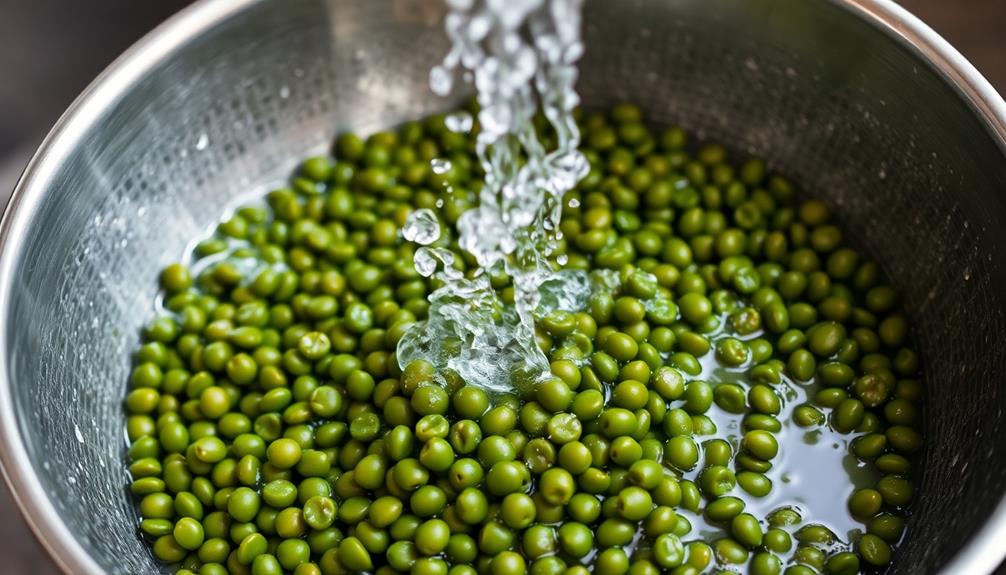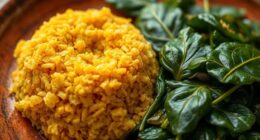Adopting a vegan diet doesn't mean compromising on protein – you can meet your nutritional needs through a variety of plant-based sources. Legumes like beans and lentils provide hearty protein and fiber, while nuts, seeds, tofu, and seitan offer nutrient-dense alternatives. By incorporating these versatile ingredients into your meals, you can enjoy delicious and satisfying dishes that align with your ethical and environmental values. With a bit of strategic planning and culinary experimentation, you'll discover the vast possibilities of crafting a nourishing and fulfilling vegan lifestyle.
Key Takeaways
- Legumes, including beans, lentils, and chickpeas, are excellent sources of plant-based protein that are also high in fiber and other essential nutrients.
- Nuts and seeds, such as almonds, walnuts, and chia seeds, provide a nutrient-dense source of protein, healthy fats, and essential minerals.
- Tofu, tempeh, and seitan are versatile protein-rich meat alternatives that can be incorporated into a wide variety of vegan dishes.
- Whole grains, such as quinoa, brown rice, and whole wheat, offer a combination of protein, complex carbohydrates, and fiber to support a balanced vegan diet.
- Incorporating a variety of protein-rich plant-based foods, along with fortified foods and supplements, can help ensure adequate nutrient intake on a vegan diet.
History
Veganism, the practice of abstaining from using animal products, has a long and storied history that dates back centuries.
In the early 19th century, the term "vegetarian" was coined, describing those who avoided meat and other animal-derived foods. As the movement gained traction, some vegetarians took their beliefs a step further, rejecting all animal products, including dairy and eggs. This more stringent approach became known as veganism, and it emerged as a distinct philosophy in the 1940s.
The modern vegan movement owes much to the pioneering work of individuals like Donald Watson, who founded the Vegan Society in the UK in 1944.
Over the decades, veganism has evolved, with an increasing focus on animal rights, environmental sustainability, and health benefits.
Today, the vegan community is a diverse and global movement, with a growing number of people embracing plant-based diets and lifestyles for a variety of ethical, environmental, and personal reasons.
Recipe
Hearty Lentil and Vegetable Stew
Lentils are a fantastic source of plant-based protein, and when combined with a variety of vegetables, they create a nourishing and satisfying stew. This recipe is easy to prepare and perfect for a cozy, plant-based meal. Chia seeds, known for their high fiber content and versatility, can also be sprinkled on top for added nutrition and texture, making this dish even more wholesome and nutritional power.
The blend of savory spices, tender lentils, and fresh produce results in a comforting dish that's sure to please even the most ardent meat-eaters. Serve this stew with crusty bread or over a bed of whole grains for a complete and fulfilling dinner.
- 1 cup dry lentils, rinsed
- 1 onion, diced
- 3 cloves garlic, minced
- 2 carrots, peeled and diced
- 2 celery stalks, diced
- 1 red bell pepper, diced
- 1 (14.5 oz) can diced tomatoes
- 4 cups vegetable broth
- 2 teaspoons dried thyme
- 1 teaspoon dried oregano
- 1 teaspoon smoked paprika
- Salt and black pepper to taste
In a large pot, sauté the onion and garlic in a bit of water or broth over medium heat until softened, about 5 minutes. Add the carrots, celery, and bell pepper, and continue cooking for an additional 5 minutes.
Pour in the diced tomatoes, vegetable broth, and spices. Bring the mixture to a boil, then reduce the heat and simmer for 20-25 minutes, or until the lentils are tender. Season with salt and pepper to taste.
To make this stew even heartier, consider adding diced potatoes or sweet potatoes. You can also customize the vegetables based on what you have on hand.
Serve the lentil stew with a sprinkle of chopped fresh parsley or a dollop of vegan sour cream for an extra touch of flavor.
Cooking Steps
Soak your beans overnight before cooking to improve their digestibility. This process enhances nutrient absorption, much like how the ancient nutritional uses of chia seeds provided essential nutrients to Mesoamerican cultures.
Drain and rinse the soaked beans, then add your favorite spices and seasonings. Simmer the beans until they're tender, then blend them into a plant-based patty for a nutritious and satisfying meal.
Step 1. Soak Beans Overnight Before Cooking

Soaking beans overnight before cooking is a simple yet essential step that can make a significant difference in the final dish. It helps to break down the complex starches and reduces the raffinose sugars responsible for gas and bloating.
To soak your beans, simply cover them with clean water and let them sit at room temperature for 8-12 hours, or overnight. This allows the beans to absorb water, softening their texture and making them easier to digest.
Once soaked, drain and rinse the beans before cooking. This removes any impurities and excess starch. You can then proceed with your recipe, whether that's simmering the beans on the stovetop or pressure cooking them.
Soaking also reduces the overall cooking time, saving you energy and making the beans more tender. Incorporate this easy step into your meal prep, and you'll enjoy tastier, more digestible bean dishes every time.
Step 2. Drain and Rinse Soaked Beans

After soaking your beans overnight, it's important to drain and rinse them before cooking. This step helps remove any impurities or excess starch that may have accumulated during the soaking process.
Simply pour the soaked beans through a colander, allowing the water to drain completely. Then, give the beans a thorough rinse under cool running water, gently stirring them with your hands to ensure they're fully rinsed.
This step not only improves the texture and flavor of the beans but also reduces the likelihood of gas or bloating, which can sometimes occur when consuming legumes. By draining and rinsing your soaked beans, you're setting the stage for a more enjoyable and nutritious plant-based meal.
Remember to repeat this process each time you cook with soaked beans to maintain optimal quality and digestibility.
Step 3. Add Spices and Seasonings

Next, season the drained and rinsed beans with your desired spices and seasonings. This is where you can really amp up the flavor and create a dish that's tailored to your taste buds.
Consider adding fragrant herbs like rosemary, thyme, or bay leaves. A pinch of cumin, chili powder, or smoked paprika can lend a delightful depth of flavor.
Don't be afraid to experiment with different spice blends, like an Italian seasoning or a curry powder. You can also toss in some minced garlic, shallots, or onions for an extra savory boost.
Additionally, incorporating essential oils such as lavender for mood enhancement can add a unique twist to your dishes.
Season to your liking, starting with smaller amounts and adjusting as needed. The key is to find the perfect balance of spices that complements the natural earthiness of the beans.
With a little creativity, you can transform these humble legumes into a truly satisfying and flavorful vegan protein-packed meal.
Step 4. Simmer Beans Until Tender

Once you've seasoned the beans to your liking, it's time to simmer them until they're tender. Bring the pot to a gentle simmer, then reduce the heat to low, and let the beans cook for 30-60 minutes, stirring occasionally.
The cooking time will depend on the type of beans you're using, so keep an eye on them and test for doneness. You're looking for the beans to be soft and easily mashable with a fork.
As the beans simmer, you may need to add more water if the liquid level gets too low. Just add a splash or two to maintain the desired consistency.
Be patient during this process – the longer you let the beans cook, the creamier and more flavorful they'll become.
Once they're tender, you can use the beans in your favorite recipes, mash them into a spread, or enjoy them as a simple side dish.
Simmering is the key to transforming dried beans into a delicious, protein-packed ingredient.
Step 5. Blend Beans Into Plant-Based Patty

Blending the cooked beans into a plant-based patty is a simple and versatile process. First, drain and rinse the cooked beans, then transfer them to a food processor or high-powered blender. Pulse the beans a few times to break them down, but don't overmix – you want to maintain some texture.
Next, add any desired seasonings, such as garlic powder, onion powder, or your favorite herbs and spices. Pulse again until the mixture is well combined but still has some bean chunks.
Now, form the bean mixture into patty shapes, using your hands or a burger press. If the mixture is too wet, you can add a bit of breadcrumbs or flour to help it hold its shape.
Cook the patties in a lightly oiled skillet over medium heat for 3-4 minutes per side, or until they're golden brown and heated through. Serve the bean patties on buns, in wraps, or over salads for a satisfying vegan meal.
Final Thoughts
Though the selection of vegan protein sources may seem daunting at first, with a little creativity and an open mind, you'll find that there are countless delicious and nutritious options to incorporate into your diet.
From hearty legumes and nutrient-dense nuts to versatile tofu and seitan, the possibilities are endless. Don't be afraid to experiment and mix things up, as this will keep your meals interesting and ensure you're getting a well-rounded intake of essential nutrients.
Remember, the key to a successful vegan diet is balance and variety. By focusing on a diverse array of plant-based proteins, you can meet your body's needs while enjoying the many benefits of a compassionate, eco-friendly lifestyle.
With a little planning and a positive attitude, you can thrive on a vegan diet and feel great about the choices you're making for your health and the planet.
Frequently Asked Questions
How Do I Ensure I Get Enough Protein on a Vegan Diet?
To ensure you get enough protein on a vegan diet, focus on incorporating a variety of plant-based protein sources like legumes, nuts, seeds, and whole grains. Combine different proteins at meals to meet your daily needs.
What Are the Best Vegan Protein Sources to Incorporate?
You can get plenty of protein from plant-based sources like beans, lentils, tofu, tempeh, and a variety of nuts and seeds. Aim to include a protein-rich food at each meal for optimal nutrition.
How Can I Meet My Daily Protein Requirements as a Vegan?
To meet your daily protein needs as a vegan, incorporate a variety of plant-based protein sources like beans, lentils, tofu, tempeh, nuts, and whole grains. Combine these with other nutrient-dense foods to ensure you're getting all the essential amino acids.
What Are the Benefits of Consuming Plant-Based Protein?
You'll enjoy plant-based protein's health benefits, like lower cholesterol and reduced risk of chronic diseases. It's also more environmentally friendly and typically less expensive than animal-based protein. Plus, it's easy to find in a variety of delicious, plant-based foods. Tofu alternatives, such as tempeh and seitan, provide even more options for incorporating plant-based protein into your diet. These alternatives offer different textures and flavors, making it easy to find a satisfying substitute for meat in your favorite recipes. Whether you’re looking to improve your health, reduce your environmental impact, or simply try something new, plant-based protein and tofu alternatives are a great choice for anyone.
Can a Vegan Diet Provide All the Essential Amino Acids?
Yes, you can get all the essential amino acids on a vegan diet by combining different plant-based protein sources like beans, lentils, nuts, and whole grains. With proper planning, a vegan diet can provide complete protein.









